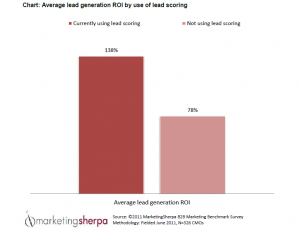Lead Scoring: CMOs realize a 138% lead gen ROI … and so can you
In last week’s blog post, I looked at the importance of lead nurturing. Some readers wanted more, so this week, I’ll dive even deeper into the complex B2B sale with a few data points and some very actionable tips on lead scoring.
First, let’s look a few data points from the 2012 MarketingSherpa B2B Benchmark Report, featuring Jen Doyle, Senior Research Manager, MarketingSherpa, as the lead author.
This chart shows the value of scoring leads based on a survey of CMOs:
Here is commentary on this chart from the report (italic emphasis is mine in the quote):
Once organizations establish lead qualification practices and define the criteria for a qualified, sales-ready lead, they need lead scoring methodologies to accurately and precisely identify qualified leads. Lead scoring is the process of adding and subtracting points to a lead’s value over time based on various lead attributes or demographics, and behaviors.
Lead scoring is one essential component of an overall funnel optimization strategy; however, the above chart analyzes one of the key benefits of only implementing this one feature. On average, organizations that currently use lead scoring experience a 77% lift in lead generation ROI, over organizations that do not currently use lead scoring.
Okay, so lead scoring is clearly a good B2B marketing practice, but the next data point isn’t so positive. Our research, through a survey of 1,745 marketers, found that 79% of B2B marketers are not engaging in lead scoring.
This week’s B2B newsletter article – “The Complex Sale: Lead scoring effort increases conversion 79%” – is a look at how Bersin & Associates, a human resources and learning professionals research and consulting firm, implemented an entirely new lead scoring program over 2011.
I interviewed Paula Reinman, Senior Vice President Marketing, Bersin, to learn the process Marketing and Sales at the company went through to create and implement a lead scoring program that fit in with the existing marketing automation software and CRM environment.
I think if you take the time to read the case study, you will take away a solid sense of implementing lead scoring, but as they say in New Orleans, this week I’m offering some lagniappe, a little something extra from Paula in the form of six lead scoring tips.
Hopefully these will help either improve your lead scoring activities, or even spur you to set up a program of your own if you aren’t currently engaging in lead scoring.
Here are Paula’s lead scoring tips:
Be Broad
Think creatively about the behaviors on your site that indicate that someone is a potential lead and assign points to those behaviors. Filling out a form and downloading white papers are naturals.
Consider other things that show a prospect is investing time with you:
- Watching webinar replays
- Watching video or demos on your site
- Searching specifically for your company
- Subscribing to a blog alert or RSS feed
Everyone learns differently about your products and services.
Build for Sales
Work with your sales team to create a scoring program that reflects the sales organization and strategy. If you have a specific sales development function built to qualify leads for your account executives (AEs), make your filter broader. If your leads go directly to your AEs, make the funnel narrower since they are balancing prospecting with many other sales tasks.
If your sales strategy is to call anyone from a target company, even the janitor, find and pass as many names as you can. If your strategy is to contact directors and above from Fortune 1000 companies, fewer very high-quality leads are better.
Work in Progress
Lead scoring is a dynamic and adjustable marketing tool. Constantly review the quality and disposition of your leads and work with your sales team to figure out which leads are good so you can get more of those, and which are not good so you can set up scoring to screen those out.
Metrics Matter
Agree with Sales and your leadership team on the most valuable lead metrics for your business and measure them consistently. Constantly test ideas for improved lead quality, faster movement through the funnel and better win rates and share outcomes with the organization.
Be Transparent
Create dashboards that appropriate people in your organization can view as needed to show the number, status and revenue associated with the leads you generated. You’ll provide bottom line, business-impacting information that is hugely valuable to the organization and that helps you drive alignment on where your marketing resources are spent.
Joint Accountability
Sales and Marketing are accountable for growing the business by generating and closing great leads and the handshake between the two teams is critical. Jointly set metrics and expectations around the number and quality of leads from Marketing and lead follow-up time and process for Sales. Make Sales accountable for good feedback on lead quality, and make Marketing accountable for delivering required changes.
Related Resources:
Marketo – Bersin’s marketing automation vendor
Salesforce.com – Bersin’s CRM vendor
LeadMD – Bersin’s marketing automation and CRM consultant
Marketing Strategy: Revenue-oriented approach leads to 700% two-year growth
Special Report: When to Adopt Lead Scoring, and How to Justify the Investment
B2B Marketing: Combining sales and marketing knowledge to improve lead qualification
Lead scoring thoughts to share
Categories: Lead Generation B2B marketing, lead nurturing, lead scoring, Sales and Marketing alignment











Lead Scoring: CMOs realize a 138% lead gen ROI … and so can you